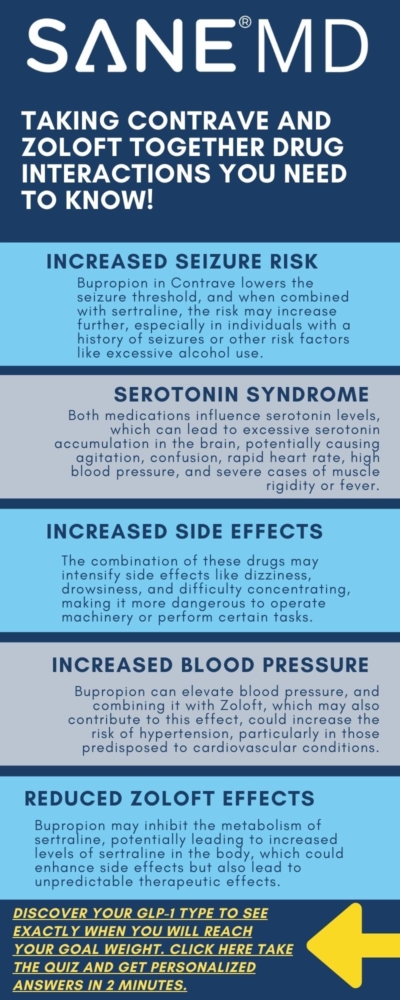Contrave and Zoloft Together: Drug Interactions Explained
Dr. Matthew Olesiak, MD, is the Chief Medical Director at SANESolution, a renowned wellness technology company dedicated to providing evidence-based solutions for optimal living. Dr. Olesiak earned his medical degree from the prestigious Jagiellonian University Medical College in Kraków, Poland, where he developed a strong foundation in medicine.

Contrave is a prescription weight loss drug that combines bupropion naltrexone to help certain patients manage obesity. Zoloft (sertraline) is a selective serotonin reuptake inhibitor (SSRI) used to treat depression and anxiety disorders. When taking Contrave and Zoloft together, it may lead to drug interactions that require careful monitoring.
The article explores potential Contrave and Zoloft drug interactions for the safe usage of both drugs.
Key Takeaways
- Taking Contrave and Zoloft (sertraline) together may increase the risk of serotonin syndrome and other drug interactions.
- Bupropion naltrexone, the active ingredients in Contrave, can affect plasma concentrations of sertraline and other medications.
- Individuals with seizure disorder, eating disorders, head trauma, or high blood pressure should consult their healthcare provider before starting Contrave.
Understanding Contrave and Zoloft
Contrave contains bupropion hydrochloride and naltrexone, two active ingredients that work to suppress appetite and regulate the brain’s reward system. Zoloft (sertraline), an SSRI, affects serotonergic activity, helping patients manage depression and anxiety. However, combining these medications can pose certain risks.
“Patients should always consult their healthcare provider before combining any prescribed medications to minimize the risk of potential interactions,” says Dr. Matthew Olesiak, Chief Medical Director at SANE MD.
Contrave and Zoloft Drug Interactions Overview
| Interaction Type | Description | Potential Risks | Precautions |
|---|---|---|---|
| Serotonin Syndrome | Increased serotonergic activity due to sertraline (SSRI) and bupropion (NDRI). | Rapid heart rate, high blood pressure, confusion, excessive sweating, seizures, fever, tremors. | Monitor for symptoms; avoid combining with other serotonin-enhancing drugs (e.g., MAOIs, triptans, TCAs). |
| Seizure Risk | Bupropion lowers the seizure threshold, increasing risk when combined with sertraline. | Seizures, dizziness, muscle rigidity, loss of coordination. | Avoid in patients with a history of seizures, eating disorders, or head trauma. |
| Blood Pressure Elevation | Bupropion and sertraline can both affect cardiovascular function. | High blood pressure, headaches, chest pain, blurred vision. | Regular blood pressure monitoring; avoid high-fat meals with Contrave. |
| Plasma Concentration Changes | Bupropion affects drugs metabolized by CYP450 2D6. | Increased drug levels, risk of serotonin syndrome, nausea, or reduced effectiveness. | Dose adjustments may be needed; avoid additional CYP450 2D6 inhibitors. |
| Opioid Withdrawal | Naltrexone in Contrave blocks opioid receptors. | Intense cravings, nausea, anxiety, muscle aches, restlessness. | Avoid in patients using opioids; ensure opioid-free period before starting Contrave. |
| Alcohol Consumption | Combining alcohol with Contrave can increase side effects and seizure risk. | Dizziness, nausea, rapid heart rate, mood swings. | Gradually reduce alcohol intake instead of abrupt cessation. |
| Monoamine Oxidase Inhibitors (MAOIs) | MAOIs enhance neurotransmitter levels, increasing serotonin syndrome risk. | Extremely high blood pressure, hallucinations, seizures, hyperthermia. | Wait at least 14 days after stopping MAOIs before starting Contrave. |
| Other Antidepressants (SSRIs, SNRIs, TCAs) | Risk of excessive serotonin buildup and altered drug metabolism. | Serotonin syndrome, nausea, dizziness, mood swings. | Use with caution; monitor for symptoms. |
| Over-the-Counter Medications | Decongestants and weight loss supplements may worsen Contrave side effects. | Increased blood pressure, seizures, anxiety. | Consult a pharmacist before taking OTC medications. |
| Cardiovascular Disease & Hypertension | Contrave can increase blood pressure and heart rate. | Increased risk of stroke, heart attack. |
Regular monitoring and dose adjustments if necessary.
How Do Contrave and Zoloft Interact?
Just like taking Prozac and Contrave together, drug Interactions can occur with Zoloft.
1. Serotonin Syndrome Risk
One of the most serious drug interactions between Contrave and Zoloft is the increased risk of serotonin syndrome. This condition occurs when sertraline, a selective serotonin reuptake inhibitor (SSRI), and bupropion hydrochloride, a norepinephrine-dopamine reuptake inhibitor (NDRI), significantly raise serotonergic activity in the brain. Serotonin syndrome symptoms include altered mental status, hypertension, and tremor.
The excessive accumulation of serotonin can overstimulate the nervous system, leading to severe complications.
Symptoms of Serotonin Syndrome:
- Rapid heart rate (tachycardia), which can become life-threatening if untreated
- High blood pressure, sometimes escalating to hypertensive crisis
- Confusion, agitation, or restlessness
- Excessive sweating and shivering
- Seizures, muscle rigidity, or tremors
- Dilated pupils and sensitivity to light
- Loss of coordination, dizziness, or unsteady walking
- Fever, which can progress to hyperthermia, a critical condition requiring emergency intervention
Although serotonin syndrome induced by Contrave and Zoloft together is rare, it can be fatal if not identified and managed promptly. Patients should monitor closely for any symptoms and seek medical attention immediately if they experience severe reactions.
Important Note: The risk of serotonin syndrome further increases if patients take other drugs that enhance serotonin levels, such as monoamine oxidase inhibitors (MAOIs), tricyclic antidepressants, triptans (for migraines), or illicit substances like MDMA (ecstasy).
2. Seizure Risk
Bupropion hydrochloride, one of the key components of Contrave, is known to lower the seizure threshold. This means that individuals taking Contrave interact with other drugs that influence neurological activity—such as Zoloft (sertraline)—are at higher risk of seizures.
The occurrence of seizures when using bupropion is estimated to be around 0.4% at doses ranging from 300 to 450 mg per day.
Certain risk factors make patients even more vulnerable, including:
- History of seizure disorder
- Previous head trauma or brain injuries
- Eating disorders, particularly anorexia nervosa or bulimia nervosa
- Drinking alcohol regularly or suddenly stopping drinking alcohol while on Contrave
- Taking Contrave alongside other stimulants, including certain over-the-counter decongestants or prescribed medications that affect brain function
To minimize the risk of seizures, patients should follow their prescribed dose range and avoid abrupt dosage changes.
Taking Contrave in excessive amounts or skipping doses unpredictably can also trigger seizures.
3. Blood Pressure Elevation
Both bupropion naltrexone and sertraline can influence blood pressure, making cardiovascular monitoring essential for individuals with high blood pressure or heart disease.
- Bupropion hydrochloride can cause systemic exposure to increased levels of norepinephrine, which can raise blood pressure and heart rate.
- Sertraline has a more indirect impact but can still contribute to elevated blood pressure in some patients.
The risk of severely high blood pressure is even greater for individuals with the following health conditions:
- Uncontrolled hypertension
- Cardiovascular disease
- History of stroke or aneurysm
What Patients Should Do:
- Monitor closely for signs of severely high blood pressure, such as persistent headaches, blurred vision, or chest pain.
- Check blood pressure regularly, especially when starting Contrave or increasing the dose.
- Avoid high-fat meals while taking Contrave, as they can affect how the drug is absorbed, potentially worsening cardiovascular effects.
4. Plasma Concentration Changes
Coadministration of bupropion may lead to elevated plasma concentrations of medications metabolized by CYP450 2D6. This interaction necessitates careful monitoring and potential dose adjustments to avoid adverse effects and ensure effective treatment outcomes.
This interaction may lead to:
- Increased drug levels, heightening the risk of seizures, serotonin syndrome, or nausea.
- Reduced effectiveness, meaning that either Contrave or Zoloft may not work as intended.
Patients should avoid taking other medications that affect plasma concentrations, such as carbamazepine or over-the-counter supplements known to interact with psychiatric drugs. Doctors may need to adjust the dose of one or both medications based on individual response.
5. Increased Risk of Opioid Withdrawal
Since Contrave contains naltrexone, an opioid antagonist, it blocks opioid receptors in the brain. While this is beneficial for weight loss, it can lead to opioid withdrawal symptoms in individuals who have recently used opioids or are currently taking other drugs for pain management.
Opioid withdrawal symptoms may include:
- Intense cravings
- Sweating and chills
- Nausea and vomiting
- Restlessness and anxiety
- Muscle aches and tremors
Who Is Most at Risk?
- Patients prescribed opioids for chronic pain management
- Individuals who take tricyclic antidepressants or other medications that affect opioid receptors
- Patients in recovery from opioid use disorder
If you are taking Contrave and have a history of opioid use, monitor closely for withdrawal symptoms and discuss alternative treatment options with your healthcare provider.
Additional Considerations
Alcohol and Contrave
Patients should not suddenly stop drinking alcohol while taking Contrave because this can significantly increase the risk of seizures. Alcohol withdrawal—especially for individuals who consume alcohol regularly—can disrupt brain chemistry, lowering the seizure threshold.
Since bupropion hydrochloride already increases the risk of seizures, stopping alcohol suddenly while on Contrave heightens this danger.
Additionally, drinking alcohol while taking bupropion naltrexone can intensify side effects, including:
- Dizziness and loss of coordination
- Nausea and vomiting
- Severe headaches
- Rapid heart rate and increased blood pressure
- Mood swings or heightened anxiety
For patients who consume alcohol regularly, doctors may recommend a gradual reduction rather than quitting abruptly while on Contrave.
Individuals with a history of alcohol dependence, binge drinking, or liver disease should discuss risk factors with their healthcare provider before starting Contrave.
Important Note: Chronic alcohol use can also contribute to liver damage, which may impair how the body metabolizes Contrave and other medications.
Monoamine Oxidase Inhibitors (MAOIs) and Contrave
Combining monoamine oxidase inhibitors (MAOIs) with Contrave or Zoloft (sertraline) is considered highly dangerous due to the increased risk of serotonin syndrome and severely high blood pressure.
MAOIs, such as:
- Phenelzine (Nardil)
- Tranylcypromine (Parnate)
- Isocarboxazid (Marplan)
- Selegiline (Emsam, Zelapar)
work by blocking the breakdown of neurotransmitters like serotonin, dopamine, and norepinephrine. When combined with bupropion naltrexone or sertraline, this can lead to a dangerous buildup of serotonin, resulting in:
- Extremely high blood pressure (hypertensive crisis)
- Severe confusion and hallucinations
- Seizures or coma
- Life-threatening temperature spikes (hyperthermia)
Patients must wait at least 14 days after stopping an MAOI before starting Contrave or Zoloft to avoid dangerous interactions.
Warning: Some over-the-counter herbal supplements, such as St. John’s Wort, also have monoamine oxidase inhibitor-like effects and should be avoided when taking Contrave.
Other Medications and Drug Interactions
Contrave drug interactions are common with multiple other drugs, including prescription, over-the-counter, and herbal supplements.
Certain medications can interfere with how Contrave is metabolized, either increasing the risk of side effects or reducing its effectiveness.

Common Drug Interactions with Contrave:
- Carbamazepine, Phenytoin, and Other Seizure Medications
- These drugs can lower plasma concentrations of bupropion, making Contrave less effective.
- Patients with a seizure disorder should not use Contrave due to the risk of seizures.
- Over-the-Counter Cold and Allergy Medications
- Many OTC cold and flu remedies contain pseudoephedrine or dextromethorphan, which can increase blood pressure and the risk of serotonin syndrome when combined with Contrave.
- Patients should check with a pharmacist before using over-the-counter medications.
- Other Antidepressants (SSRIs, SNRIs, TCAs)
- Combining Contrave with other antidepressants, such as fluoxetine (Prozac), venlafaxine (Effexor), or amitriptyline, or Cymbalta can cause drug interactions that lead to serotonin syndrome induced side effects.
- Tricyclic antidepressants (TCAs) may also interact with bupropion naltrexone, increasing plasma concentrations and side effect risks.
- Opioid Medications and Pain Relievers
- Contrave contains naltrexone, which blocks opioid receptors.
- Patients taking morphine, oxycodone, tramadol, or hydrocodone will experience opioid withdrawal symptoms if they start Contrave without first tapering off opioids.
- Blood Pressure Medications
- Bupropion hydrochloride can increase blood pressure, so patients on medications for hypertension should monitor closely.
- Combining Contrave interact with certain blood pressure medications, like beta-blockers, may require dose adjustments.
- Methylene Blue and Intravenous Dyes
- Methylene blue, used for certain medical tests and procedures, can cause serotonin syndrome when combined with Zoloft or Contrave.
- Herbal Supplements and Weight Loss Aids
- Patients should avoid herbal weight loss supplements or diet pills while taking Contrave, as they may increase the risk of seizures, high blood pressure, and drug interactions.
- Recreational drugs. It may surprise you, but Contrave and alcohol, as well as Contrave and marijuana drug interactions can occur.
Expert Insight: “Patients must be aware of how their medications may interact, especially with prescription weight loss drugs like Contrave,” says Dr. Matthew Olesiak. “Always consult a healthcare provider before adding any new medications or supplements to your regimen.”
Managing the Risks of Taking Contrave
Knowing Contrave side effects and adhering to safety considerations can help you avoid dangerous drug interactions.
1. Monitor for Symptoms
When starting Contrave, patients must monitor closely for symptoms that may indicate potential side effects or drug interactions. While some mild reactions are expected, severe or persistent symptoms require immediate medical attention.
Common Symptoms to Watch For:
- Nausea and vomiting are among the most frequently reported side effects of Contrave, especially during the initial dose adjustment period.
- Dizziness and lightheadedness – May be a sign of blood pressure changes or central nervous system effects.
- Headaches – Often mild but can become severe if blood pressure increases significantly.
- Insomnia or restlessness – Bupropion can be stimulating, making it difficult to sleep, especially when taken later in the day.
- Dry mouth and excessive sweating – Common with bupropion naltrexone, but should be monitored if severe.
- Heart palpitations or increased heart rate – Could indicate high blood pressure or cardiovascular effects that require monitoring.
Serious Symptoms Requiring Immediate Medical Attention:
- Severe high blood pressure (e.g., pounding headache, chest pain, blurred vision)
- Signs of serotonin syndrome (e.g., confusion, muscle rigidity, excessive sweating, high fever)
- Seizures (especially in patients with seizure disorder, eating disorders, or head trauma)
- Allergic reaction (e.g., rash, swelling, difficulty breathing)
- Suicidal thoughts or extreme mood changes
If any of these symptoms occur, patients should stop taking Contrave and seek medical attention immediately.
2. Follow the Recommended Dose
Maintaining the correct dose range is essential for minimizing risk factors while taking Contrave. This medication requires a gradual titration schedule to allow the body to adjust.
Recommended Dosing Schedule for Contrave:
- Week 1: One tablet (8 mg naltrexone / 90 mg bupropion) in the morning
- Week 2: One tablet in the morning, one in the evening
- Week 3: Two tablets in the morning, one in the evening
- Week 4 and beyond: Two tablets in the morning, two in the evening
Why a Gradual Increase Matters:
- Prevents severe nausea – One of the most reported side effects is nausea, which can be reduced by increasing the dose slowly.
- Minimizes the risk of seizures – Bupropion hydrochloride lowers the seizure threshold, and taking too much too soon increases the risk.
- Helps manage blood pressure changes—Contrave can cause blood pressure elevation, so Patients with high blood pressure need careful monitoring.
Patients should not stop taking Contrave suddenly, as this can trigger withdrawal symptoms or worsen side effects. Instead, any discontinuation should be done under medical supervision.
3. Be Cautious with Other Medications
Because Contrave interacts with many medications, including over-the-counter and prescription drugs, patients should discuss their full medication list with their doctor before starting Contrave.
High-Risk Medication Interactions:
- Methylene blue – Can cause serotonin syndrome when combined with Zoloft or Contrave.
- Wellbutrin SR or other forms of bupropion—Contrave contains bupropion hydrochloride, and combining it with Wellbutrin SR can lead to dangerously high plasma concentrations, increasing the risk of seizures.
- Other antidepressants – Tricyclic antidepressants (TCAs), SSRIs, and SNRIs can lead to serotonin syndrome induced complications.
- Opioid medications – Naltrexone in Contrave blocks opioid receptors, meaning it can trigger opioid withdrawal symptoms if the patient is taking morphine, oxycodone, tramadol, or hydrocodone.
- Over-the-counter cold medicines – Decongestants containing pseudoephedrine can increase blood pressure, leading to severely high blood pressure when taken with Contrave.
Important Tip: Patients should always inform their doctor or pharmacist about any new drugs before taking them with Contrave to reduce the risk of drug interactions.
4. Consider Individual Health Conditions
Contrave may not be suitable for individuals with certain health conditions. Some conditions increase the risk of severe side effects or reduce the medication’s effectiveness.
Health Conditions That Require Caution:
- Bipolar Disorder:
- Bupropion hydrochloride can induce mania or hypomania in individuals with bipolar disorder.
- Patients with a history of suicidal thoughts should be closely monitored.
- High Blood Pressure or Heart Disease:
- Contrave interacts with cardiovascular function, increasing blood pressure and heart rate.
- Individuals with uncontrolled high blood pressure are at higher risk for severely high blood pressure episodes.
- Liver Damage or Impairment:
- Naltrexone is metabolized in the liver, and patients with liver disease may have difficulty processing the medication.
- Patients with a history of alcohol dependence should be extra cautious, as liver damage from alcohol may further complicate Contrave’s effects.
- Seizure Disorder or Head Trauma:
- Bupropion hydrochloride is known to increase the risk of seizures, making Contrave unsuitable for patients with a history of head trauma or seizure disorder.
- Eating Disorders (Anorexia or Bulimia):
- Contrave interacts with neurotransmitter systems in a way that makes it dangerous for individuals with anorexia nervosa or bulimia nervosa.
- These disorders already carry a higher risk of electrolyte imbalances, which further increase the risk of seizures when combined with bupropion naltrexone.
When to Seek Medical Attention
- If you experience severely high blood pressure, confusion, or serotonin syndrome induced symptoms
- If you develop an allergic reaction, such as rash, swelling, or difficulty breathing
- If you have signs of suicidal thoughts or mood changes
- If you experience persistent nausea or dizziness
If you or someone you know is struggling with suicidal thoughts, seek help from the crisis lifeline immediately.
Frequently Asked Questions (FAQ) About Contrave and Zoloft
Combining Contrave with Zoloft or other medications raises important concerns about drug interactions, potential side effects, and safety precautions.
Below are some common questions and detailed answers to help clarify whether taking Contrave with antidepressants or weight loss drugs is appropriate for you.
1. Can you take antidepressants with Contrave?
It is possible to take antidepressants with Contrave, but it must be done cautiously under a doctor’s supervision. Since Contrave contains bupropion hydrochloride, which affects dopamine and norepinephrine levels, adding an antidepressant, such as an SSRI (Zoloft, Prozac, Lexapro) or an SNRI (Effexor, Cymbalta), can increase the risk of serotonin syndrome and other drug interactions. Additionally, some tricyclic antidepressants (TCAs) can interfere with bupropion naltrexone, altering drug effectiveness and plasma concentrations.
Contrave carries a boxed warning due to the risk of suicidal thoughts and behaviors, which is associated with its antidepressant component, bupropion hydrochloride, particularly in young adults and adolescents.
If you are currently taking antidepressants, your healthcare provider may need to adjust dosages to reduce risk factors and monitor for side effects such as high blood pressure, nausea, or mood changes. It is crucial to maintain open communication with your healthcare provider to ensure any signs of mood changes or suicidal thoughts are addressed promptly.
2. Can you take Zoloft and weight loss pills together?
Taking Zoloft with weight loss drugs should be approached carefully, as many prescription and over-the-counter weight loss medications affect neurotransmitters, blood pressure, and metabolism. Contrave is one of the few FDA-approved weight loss drugs that contains bupropion naltrexone, which can interact with sertraline (Zoloft) by increasing serotonergic activity and the risk of serotonin syndrome.
Over-the-counter weight loss supplements, especially those containing stimulants like caffeine, ephedrine, or synephrine, may cause additional drug interactions, potentially raising blood pressure or triggering seizures in sensitive individuals. If you’re considering taking Zoloft and a weight loss pill together, consult your doctor to determine a safe treatment plan.
3. Can Zoloft and bupropion be taken together?
Yes, Zoloft (sertraline) and bupropion can be taken together in some cases, as healthcare providers sometimes prescribe them together to manage treatment-resistant depression or major depressive disorder. However, because bupropion hydrochloride affects dopamine and norepinephrine, and sertraline primarily influences serotonin levels, there is a potential risk of serotonin syndrome or excessive neurotransmitter stimulation.
Some patients may experience increased anxiety, agitation, insomnia, or blood pressure changes when combining the two medications. Individuals with a seizure disorder or those who are taking Contrave, which already contains bupropion naltrexone, should be particularly cautious. Close monitoring by a healthcare provider is essential to ensure safe dosage adjustments and minimize side effects.
4. What medications should I avoid with Contrave?
Several medications should be avoided or used with extreme caution while taking Contrave, as they can lead to serious drug interactions or reduce the effectiveness of treatment. Opioid medications such as morphine, oxycodone, or tramadol must be avoided, as Contrave contains naltrexone, which blocks opioid receptors and can cause opioid withdrawal symptoms. Monoamine oxidase inhibitors (MAOIs), including phenelzine, tranylcypromine, and selegiline, should not be taken with Contrave, as they can result in severely high blood pressure and serotonin syndrome.
Other medications to avoid include seizure medications like carbamazepine and phenytoin, which can alter plasma concentrations of bupropion, and over-the-counter decongestants, which may raise blood pressure. Patients should also be careful with other antidepressants, including tricyclic antidepressants and SSRIs, as they can interact with Contrave mechanisms and increase risk factors such as serotonin syndrome and seizures.
5. Can you take Contrave if you take Zoloft?
It is possible to take Contrave while taking Zoloft, but it must be done under close medical supervision to minimize drug interactions and health risks. Since Contrave contains bupropion hydrochloride, combining it with sertraline (Zoloft) can lead to increased serotonergic activity, higher blood pressure, and a greater risk of seizures in some patients. Individuals with a history of bipolar disorder, high blood pressure, head trauma, or eating disorders are at a higher risk of side effects.
Doctors may need to monitor closely for symptoms like nausea, dizziness, serotonin syndrome, or mood changes while adjusting dosages. If you are taking Contrave and Zoloft together, it is essential to report any unusual side effects and follow a carefully managed treatment plan to ensure safety.
Conclusion
Taking Contrave and Zoloft together can pose significant risks, including serotonin syndrome, seizures, and blood pressure changes. Patients should always consult a healthcare professional before combining these medications. By understanding potential drug interactions and monitoring closely, individuals can use these prescription drugs safely while managing depression and weight loss effectively.
“Understanding how Contrave interacts with other medications helps patients make informed health decisions,” says Dr. Olesiak. “Anyone considering combining these drugs should work closely with their doctor to ensure safe treatment.”
For personalized guidance, always consult your healthcare provider before starting Contrave or changing your dose.






